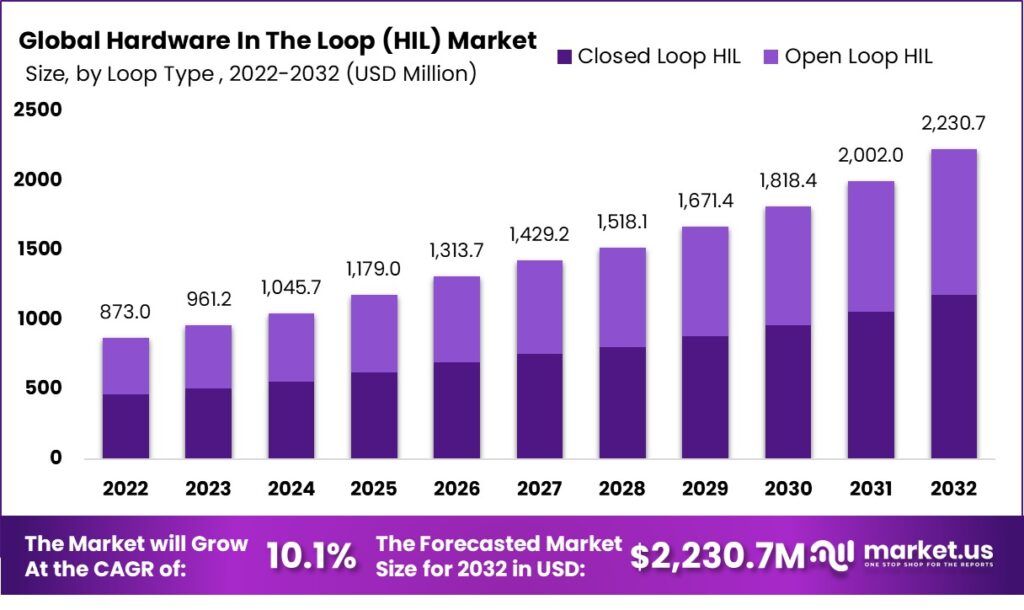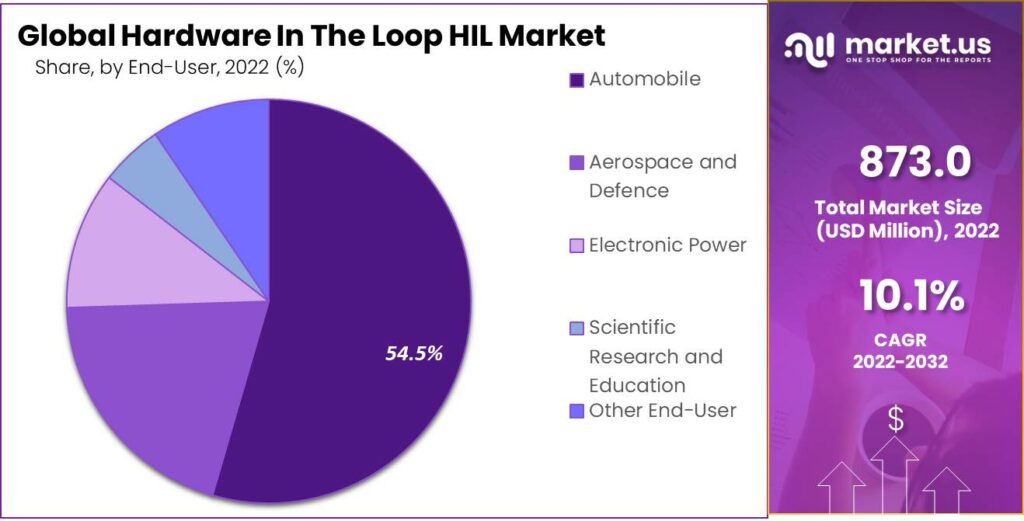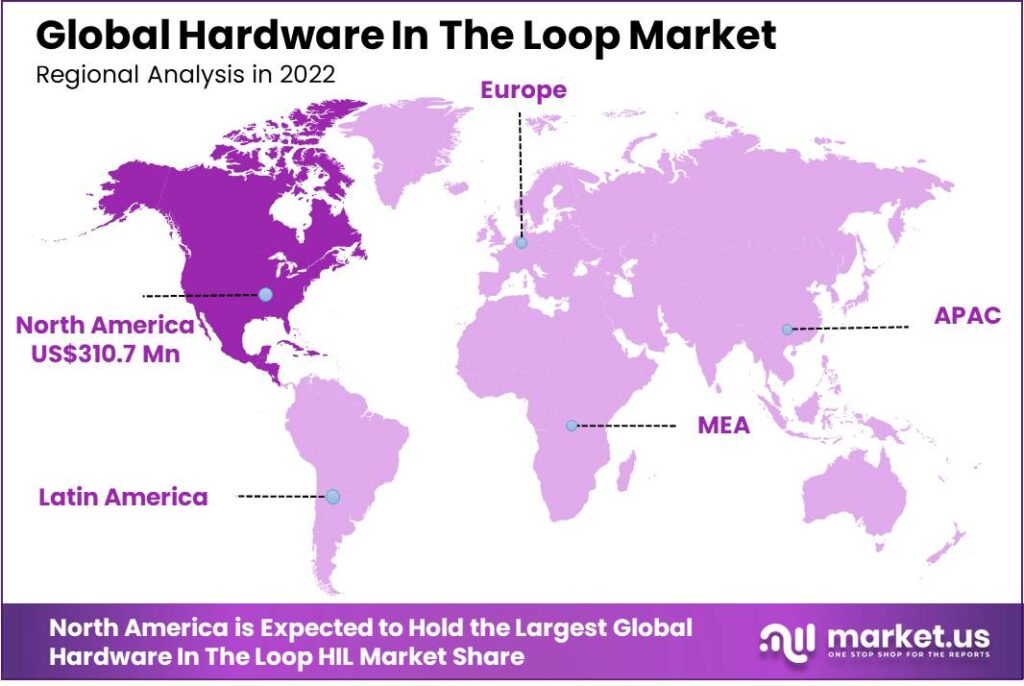New York, Jan. 15, 2024 (GLOBE NEWSWIRE) -- As per the latest analysis by market.us, The Global Hardware in The Loop (HIL) Market has shown remarkable growth, with a recorded sales figure of USD 961.2 million in 2023, marking a significant year-on-year growth rate of 10.1%. This market is poised for further expansion, with a forecasted revenue of USD 2,230.7 million by 2032.
Hardware in the Loop (HIL) is a testing and simulation technique used in various industries, including automotive, aerospace, and robotics. It involves connecting real-time hardware components (such as controllers, sensors, and actuators) with a simulated environment to validate and verify the performance of a system.
The HIL market refers to the industry and market ecosystem built around providing HIL testing solutions, products, and services. It includes companies that develop and offer HIL testing hardware, simulation software, and associated services to various industries. The HIL market has seen significant growth due to several factors. Firstly, the increasing complexity of systems in industries like automotive, aerospace, and robotics has driven the need for thorough testing and validation. HIL testing provides a cost-effective and efficient approach to validate the performance of these complex systems.
The report provides a full list of key companies, their strategies, and the latest developments. Download a PDF Sample before buying

The growing demand for safety-critical systems has led to an increased adoption of HIL testing. Industries such as automotive, where autonomous driving and advanced driver-assistance systems are rapidly evolving, require rigorous testing to ensure reliability and safety. HIL testing helps identify potential issues and validate the functionality of these systems in a controlled environment.
"The integration of artificial intelligence, machine learning, and cloud computing into HIL systems offers enhanced capabilities, such as predictive analytics and remote testing. This integration is expected to open new avenues for the application of HIL, further expanding the market." says Mr. Yogesh Shinde, Team Lead for ICT at Market.us.
Key Takeaways
- The Hardware in The Loop (HIL) market is projected to experience a Compound Annual Growth Rate (CAGR) of 10.1%, with a value of USD 2,230.7 million by 2032. This marks significant growth from USD 961.2 million in 2023.
- Closed-loop HIL holds the largest market share at 53.0%, offering greater reliability and stability in detecting and correcting errors. Open-loop HIL is gaining traction for its simplicity in design and cost-effectiveness in manufacturing processes.
- The automotive sector dominates the market with a 54.5% market share in 2022. Aerospace and defense segments are also witnessing significant growth due to the need for more intricate and advanced aerospace vehicles.
- North America held the largest market share, with 35.6% in the Global Hardware in The Loop HIL Market in 2022.
Factors Affecting the Growth of the Hardware in The Loop (HIL) Market
- Increasing Complexity of Systems: Industries such as automotive, aerospace, and robotics are experiencing a rise in the complexity of systems due to advancements in technology and the integration of various components. As systems become more intricate, the need for thorough testing and validation increases. HIL testing provides an efficient and effective way to verify the performance and functionality of complex systems, driving the demand for HIL solutions.
- Technological Innovations: The continuous evolution in computing power and simulation technologies significantly impacts the HIL market. Enhanced computational capabilities allow for more complex and realistic simulations, which are critical for testing sophisticated systems. Innovations in software and hardware integration also contribute to the development of more efficient and accurate HIL systems.
- Industry Demand: The demand from key industries such as automotive, aerospace, defense, and renewable energy is a primary driver of HIL market growth. These sectors require rigorous testing of embedded systems for safety and efficiency, particularly with the increasing complexity of electronic control systems in products like electric vehicles and smart grid technologies.
- Emphasis on Safety and Reliability: Safety and reliability are critical considerations in industries such as automotive, aerospace, and defense. HIL testing enables rigorous testing of safety-critical systems in a controlled and repeatable environment. By simulating real-world scenarios, HIL testing helps identify potential issues, validate system behavior, and ensure compliance with safety standards. The focus on safety and reliability drives the adoption of HIL solutions.
- Cost and Time Efficiency: Traditional physical testing methods can be costly and time-consuming, especially when dealing with complex systems. HIL testing offers significant cost and time savings by reducing the need for physical prototypes and enabling testing at various stages of development. HIL allows for early identification and resolution of issues, leading to shorter development cycles and faster time-to-market, making it an attractive option for companies seeking efficiency gains.
- Advances in Simulation Technology: The advancement of simulation technologies, including high-fidelity models and real-time simulation capabilities, has expanded the capabilities of HIL testing. Improved simulation accuracy, faster computation speeds, and the availability of powerful computing resources have enhanced the effectiveness of HIL testing. These technological advancements enable more realistic and detailed simulations, driving the adoption of HIL solutions.
Get Instant Access to Your Visuals-Packed Report, and request a sample @ https://market.us/report/hardware-in-the-loop-hil-market/request-sample/
Report Segmentation
Loop Type Analysis
In 2023, the Closed Loop Hardware in The Loop (HIL) segment held a dominant market position, capturing more than a 53% share of the overall market. This substantial market share can be attributed to the robust and versatile applications of Closed Loop HIL systems in various industries. These systems are extensively used in automotive, aerospace, and defense sectors due to their ability to provide realistic simulation environments. Closed Loop HIL is favored for its high fidelity and dynamic response capabilities, enabling accurate real-time testing and validation of complex systems like engine control units and flight control systems. The system's ability to interact with the device under test in a real-time feedback loop ensures that potential faults and operational inefficiencies are identified and rectified promptly.
The growth in the Closed Loop HIL market is further propelled by the increasing demand for sophisticated simulation and testing methodologies in the development of autonomous and electric vehicles. This demand is complemented by advancements in technology, such as integration with artificial intelligence and machine learning, enhancing the precision and efficiency of Closed Loop HIL systems. Furthermore, the drive towards more sustainable and energy-efficient solutions has prompted industries to adopt these systems to ensure optimal performance and regulatory compliance. The market data indicate a rising trend in investment in R&D activities, focusing on Closed Loop HIL systems, signifying the segment's potential for substantial growth in the coming years.
Elevate Your Business Strategy! Purchase the Report for Market-Driven Insights@ https://market.us/purchase-report/?report_id=105849
End-User Analysis
In 2023, the Automobile segment held a dominant market position in the Hardware in The Loop (HIL) market, capturing more than a 54.5% share. This leading position can primarily be attributed to the rapid advancements and increased complexity in automotive technology, particularly with the advent of electric vehicles (EVs) and autonomous driving systems. The automobile industry's growing focus on enhancing vehicle safety, performance, and compliance with stringent regulatory standards has driven the demand for effective and efficient testing methodologies, where HIL plays a critical role.
HIL systems provide a dynamic environment for testing and validating automotive subsystems such as engine control units, battery management systems, and advanced driver-assistance systems (ADAS). By simulating real-world scenarios, HIL enables the automobile sector to conduct thorough testing without the risks and costs associated with physical prototypes. This aspect is particularly crucial in the development of EVs and autonomous vehicles, where safety and reliability are paramount.

Sample Report Request: Unlock Valuable Insights for Your Business: https://market.us/report/hardware-in-the-loop-hil-market/request-sample/
Driver: A Rise in Automation is Propelling the Need for HIL Technological Advancements
The Hardware in the Loop (HIL) market is experiencing significant dynamism, driven by a surge in automation across various industries. This trend is propelling the need for advanced HIL technologies, as businesses increasingly seek to optimize their systems and processes through more sophisticated simulation and testing methods. HIL, a technique used to develop and test complex real-time embedded systems, is integral in this paradigm shift. It offers a controlled environment where physical systems can be simulated and interacted with, thus providing critical insights and allowing for the refinement of systems before actual deployment.
Restraining Factor: High cost of ownership and technical complexity in implementation
One of the primary restraining factors is the high cost of ownership associated with HIL systems. These costs are often exacerbated by the technical complexity involved in implementing and maintaining such systems. The intricate nature of HIL necessitates a significant investment in both hardware and software, as well as specialized personnel to manage and operate these systems effectively. This complexity can be a substantial barrier, particularly for smaller organizations or those in early stages of adopting automation technologies.
Opportunity: Adoption in new application areas such as power electronics and industrial robotics
Despite these challenges, there are considerable opportunities in the HIL market. One such opportunity is the adoption of HIL systems in new application areas, such as power electronics and industrial robotics. These sectors are increasingly relying on precise and efficient systems, where HIL can play a crucial role in ensuring reliability and performance. The ability of HIL to simulate real-world conditions and integrate seamlessly with existing systems makes it an invaluable tool in these emerging application areas.
Challenge: Complexity in creating real-time simulation
the market faces another challenge in the form of complexity in creating real-time simulation environments. Real-time simulation is critical for HIL systems as it enables the accurate replication of external stimuli and system responses. Creating these environments demands not only advanced technology but also a deep understanding of the system being tested. This complexity can limit the adoption of HIL, especially in scenarios where rapid development cycles are required.
Key Market Segments
By Loop Type
- Open Loop HIL
- Closed Loop HIL
By End-User
- Automobile
- Aerospace and Defense
- Electronic Power
- Scientific Research and Education
- Other End-User
Regional Analysis
In 2023, North America held a dominant market position in the Hardware in The Loop (HIL) market, capturing more than a 35.6% share. This predominance is largely driven by the region's advanced technological landscape and the strong presence of key industries such as automotive, aerospace, and defense. The United States, in particular, plays a pivotal role, with its substantial investment in research and development, and its focus on innovation in these sectors. The integration of HIL systems in automotive and aerospace industries for testing and validating complex electronic systems and software is a significant factor contributing to this growth.

Key Regions and Countries Covered in this Report
- North America
- The US
- Canada
- Europe
- Germany
- France
- The UK
- Spain
- Italy
- Russia
- Netherlands
- Rest of Europe
- APAC
- China
- Japan
- South Korea
- India
- Australia
- New Zealand
- Singapore
- Thailand
- Vietnam
- Rest of APAC
- Latin America
- Brazil
- Mexico
- Rest of Latin America
- Middle East & Africa
- South Africa
- Saudi Arabia
- UAE
- Rest of MEA
Key Players Analysis
The following are some of the major players in the industry
- DSpace GmbH
- National Instruments
- Vector Informatik
- ETAS
- Ipg Automotive GmbH
- MicroNova AG
- HiRain Technologies
- Opal-RT Technologies
- Shanghai KeLiang InformationTechnology Co., Ltd.
- EON
- Other Key Players
More Reports for Future Projections and Opportunities:
- Podcasting market is expected to reach around USD 133.9 bn in 2032. Between 2023 and 2032, this market is estimated to register a CAGR of 27.8%.
- Digital Transformation Market is expected to reach USD 3375 billion in 2032. This market is estimated to register the highest CAGR of 20.8%.
- Digital Twin Market size was USD 8.4 Bn in 2022 and is expected to reach USD 918.1 Bn in 2032 growing at a CAGR of 61.8% from 2023-2032.
- Combat Management System Market size is expected to be worth around USD 1386 million by 2032, growing at a CAGR of 6.5%
- Esports Market is projected to reach a revised size of USD 10,905.1 Mn by 2032, growing at a CAGR of 20.9% over the analysis period 2023-2032
- Quantum Computing Market was valued at USD 719.3 Million in 2023 and is expected to reach USD 8,285.6 Mn by 2032; At a CAGR of 31.2%.
- Smart City Market size is expected to be worth around USD 4,605.7 Billion by 2032, growing at a CAGR of 19.7% during the forecast period.
- EdTech market size is expected to be worth around USD 129 Bn by 2022 from USD 421 Bn in 2032, growing at a CAGR of 12.9% from 2022 to 2032.
- LiDAR market was valued at US$ 1.6 Bn in 2022 and is expected to reach US$ 11.6 Bn by 2032, with a CAGR of 22.5% from 2023 to 2032.
- Edge computing market size is expected to be worth around USD 206 bn by 2032 from USD 40 billion in 2022, growing at a CAGR of 18.3%.
- Chatbot Market size was valued at USD 6 billion in 2023 and is expected to reach USD 42 billion by 2032 with a CAGR of 23.91%.
- Cyber Insurance Market is poised to reach USD 90.6 Bn by 2033, growing at a CAGR of 22.3% during forecast period 2023-2033.
- Cloud Gaming Market size is expected to be worth around USD 143.4 Billion by 2032 from USD 3.4 Billion in 2022, growing at a CAGR of 46.9%.
- Identity and Access Management Market was valued at USD 14.7 Bn. Between 2023 and 2032, register the highest CAGR of 13.7%.
- Wearable Technology Market size is expected to be worth around USD 231 Billion by 2032 , growing at a CAGR of 14.60%.
- Digital Currency Market size is expected to be worth around USD 76.9 Bn by 2032 from USD 25.2 Bn in 2022, growing at a CAGR of 12.13%
- Computer Vision Market is projected to reach a valuation of USD 58.9 Bn by 2033, at a CAGR of 13.5%, from USD 16.6 Bn in 2023.
- ERP Software Market size is expected to be worth around USD 136.1 Billion by 2032, growing at a CAGR of 10.5% during the forecast period.
- Field-Programmable Gate Array (FPGA) Market size is expected to reach USD 13.5 bn in 2032, at a CAGR of 7.8%.
About Us
Market.US (Powered by Prudour Pvt Ltd) specializes in in-depth market research and analysis and has been proving its mettle as a consulting and customized market research company, apart from being a much sought-after syndicated market research report-providing firm. Market.US provides customization to suit any specific or unique requirement and tailor-makes reports as per request. We go beyond boundaries to take analytics, analysis, study, and outlook to newer heights and broader horizons.
Follow Us On LinkedIn Facebook Twitter
Our Blog:
